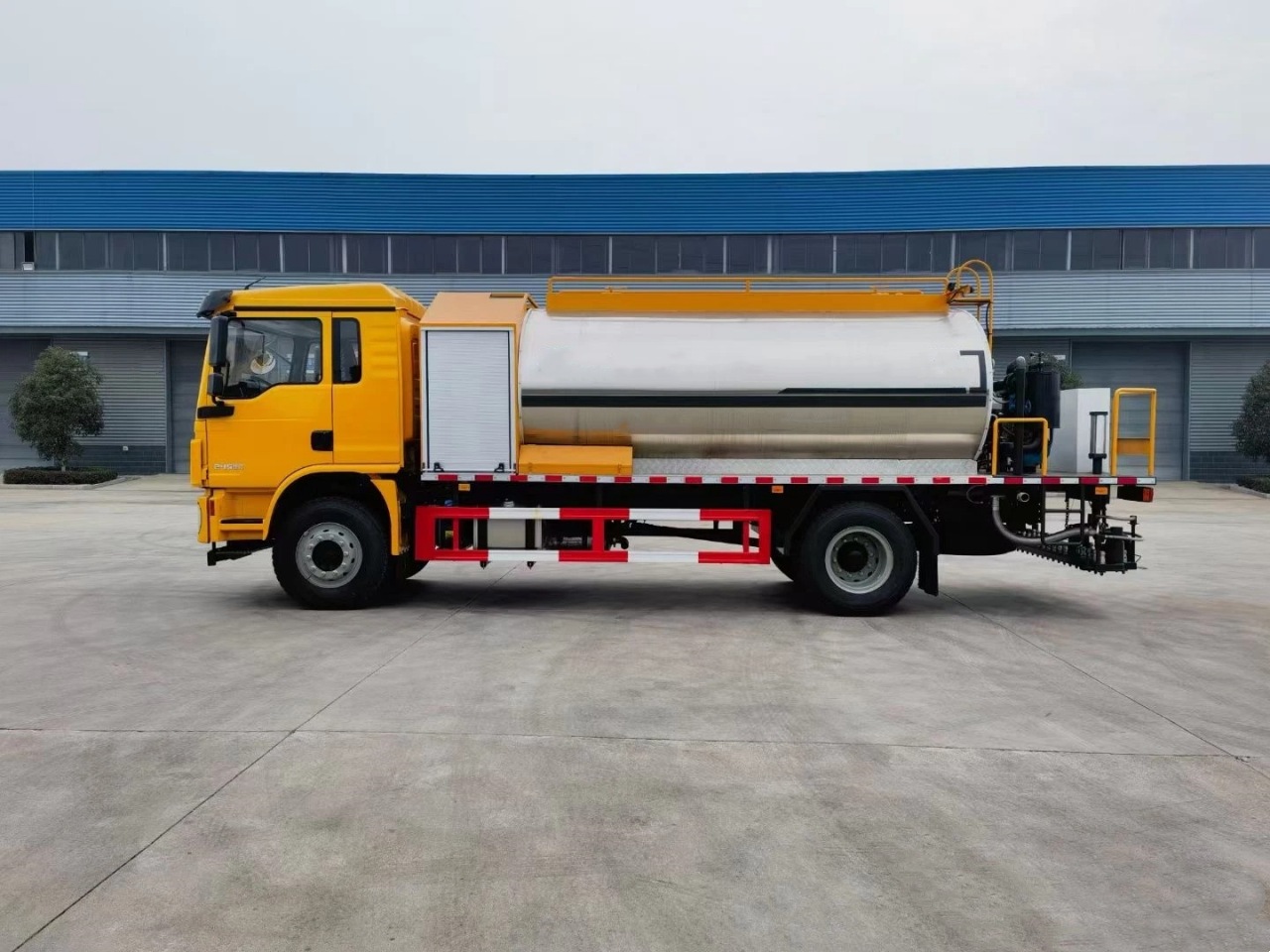Introduction
Asphalt tank trucks, also known as bitumen distributors, are specialized vehicles used in road construction and maintenance. They play a crucial role in transporting, heating, and distributing liquid asphalt for paving, patching, and sealing applications. These trucks are designed to handle high-viscosity materials while ensuring even distribution and temperature control. In this article, we will explore the construction of asphalt tank trucks, their components, and the essential maintenance required to keep them operational.
Construction of Asphalt Tank Trucks
1. Chassis and Frame
The chassis forms the structural foundation of an asphalt tank truck, designed to withstand the heavy loads and dynamic forces encountered during transport and distribution. Depending on the truck’s capacity and intended use, manufacturers select heavy-duty chassis from brands like Freightliner, Mack, Peterbilt, or Volvo.
- Frame Strength: The frame is typically reinforced with high-strength steel to support the weight of the asphalt tank and equipment.
- Axle Configuration: Single, tandem, or tridem axle configurations are used to distribute weight efficiently and meet load regulations.
- Suspension System: Heavy-duty leaf springs or air suspension systems are used for stability and comfort during operation.
2. Asphalt Storage Tank
The asphalt storage tank is the most critical component of an asphalt tank truck, designed to store and heat the bitumen to the required temperature.
- Material: Tanks are typically made of high-grade stainless steel or carbon steel with an internal insulation layer to retain heat.
- Capacity: Asphalt tanks range from 1,500 to 12,000 gallons, depending on project requirements.
- Heating System: Tanks feature diesel burners, propane-fired heating coils, or electric heating elements to maintain the temperature of the asphalt.
- Agitation Mechanism: Some tanks include agitators or circulation pumps to prevent asphalt settling and maintain uniform consistency.
3. Pumping and Spraying System
Efficient asphalt distribution is achieved through precision pumping and spraying systems.
- Pumps: Typically, asphalt trucks use gear pumps or centrifugal pumps, capable of handling high-viscosity materials.
- Spray Bar: A hydraulically or pneumatically controlled spray bar ensures an even application of asphalt.
- Nozzles: Adjustable nozzles allow for different spray patterns and application rates based on project requirements.
- Circulation System: Some trucks have circulation loops to keep asphalt from solidifying in pipelines and spray bars.
4. Control Systems
Modern asphalt tank trucks integrate advanced control systems to enhance precision and ease of operation.
- Automatic Controls: Digital controllers regulate asphalt temperature and flow rates.
- Cab-mounted Console: Operators can adjust spray width, pressure, and distribution from the truck cab.
- GPS & Telematics: Fleet management systems provide real-time tracking of truck location, temperature monitoring, and performance diagnostics.
5. Safety Features
Safety is a key consideration in asphalt tank truck design to prevent accidents and ensure smooth operations.
- Overflow Prevention: Automatic shut-off valves prevent overfilling.
- Burner Safety Mechanisms: Flame-out detection systems shut off burners in case of malfunction.
- Emergency Shut-off: A manual or automatic emergency stop system prevents asphalt spills or overheating.
- Fire Suppression System: Trucks may be equipped with fire suppression equipment to mitigate fire risks.
Maintenance of Asphalt Tank Trucks
Proper maintenance ensures asphalt tank trucks remain efficient and operational. Regular servicing prevents costly breakdowns and extends the lifespan of the vehicle and its components.
1. Routine Inspection and Servicing
Daily, weekly, and monthly inspections help detect issues before they escalate into major failures.
- Daily Inspections:
- Check fluid levels (oil, coolant, and hydraulic fluids).
- Inspect hoses, valves, and spray nozzles for leaks or clogs.
- Ensure all safety features and emergency shut-offs are operational.
- Weekly Inspections:
- Clean filters and check burner operation.
- Inspect tires for wear and proper inflation.
- Verify pump and circulation system performance.
- Monthly Inspections:
- Examine heating elements and insulation layers.
- Grease all moving parts, including pumps and spray bars.
- Check control system calibration and update software if necessary.
2. Asphalt Tank Cleaning
Asphalt residue can accumulate over time, leading to reduced efficiency and potential clogs.
- Flushing the System: Use flushing oils or diesel to clean pipelines and pumps.
- Steam Cleaning: Steam is used to remove hardened asphalt from the tank and nozzles.
- Scraping and Manual Cleaning: When necessary, manually remove stubborn deposits.
3. Pump and Spray System Maintenance
The pump and spray bar system require consistent maintenance to prevent clogging and wear.
- Pump Maintenance:
- Check for leaks and worn-out seals.
- Lubricate bearings and moving parts.
- Test pressure levels and flow rates.
- Spray Bar Maintenance:
- Inspect nozzles for clogging and replace if needed.
- Test hydraulic or pneumatic controls for smooth operation.
- Clean and calibrate spray bar settings for accurate application.
4. Heating System Maintenance
Since asphalt must be kept at specific temperatures, the heating system must be in top condition.
- Burner Maintenance:
- Check fuel lines and filters for blockages.
- Test ignition systems and flame sensors.
- Clean soot and carbon deposits from burners.
- Electric Heater Maintenance:
- Inspect wiring and electrical connections.
- Verify thermostat accuracy and recalibrate if needed.
5. Chassis and Engine Maintenance
To ensure reliable transport, the truck’s engine and chassis must be well-maintained.
- Engine Maintenance:
- Regular oil and filter changes.
- Inspect coolant system and belts.
- Check fuel system for leaks or blockages.
- Chassis Maintenance:
- Inspect frame for cracks or corrosion.
- Check brake system and air lines.
- Ensure proper suspension function.
Conclusion
Asphalt tank trucks are indispensable in road construction and maintenance, providing precise asphalt transport and application. Their construction involves a robust chassis, insulated storage tanks, heating mechanisms, precision spraying systems, and safety features. To ensure optimal performance, routine maintenance is essential, covering inspections, tank cleaning, pump servicing, and heating system upkeep. By following a strict maintenance schedule, operators can extend the lifespan of their asphalt tank trucks, reduce operational downtime, and ensure efficient asphalt distribution in every project.



